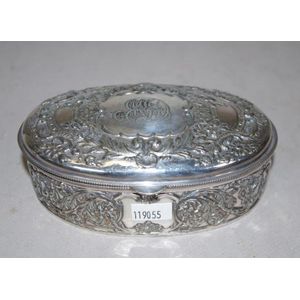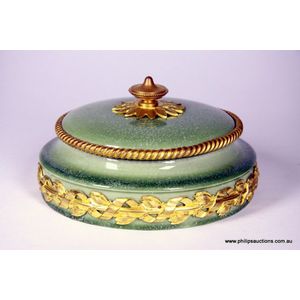Tibetan Silver Box with Gilded Figures and Auspicious Plaques
You must be a subscriber, and be logged in to view price and dealer details.
Subscribe Now to view actual auction price for this item
When you subscribe, you have the option of setting the currency in which to display prices to $Au, $US, $NZ or Stg.
- Gilding - Gilding is a method of ornamentation whereby a thin sheet of gold metal is applied to items made of wood, leather, ceramics, glass and silver for decorative purposes.
For furniture including mirrors, the sheet of gold is usually applied over a coating of gesso. Gesso is a mixture of plaster of Paris and gypsum mixed with water and then applied to the carved wooden frames of mirrors and picture frames as a base for applying the gold leaf. After numerous coats of gesso have been applied, allowed to dry and then sanded a coat of "bole", a usually red coloured mixture of clay and glue is brushed on and allowed to dry, after which the gold leaf is applied. Over time parts of the gilding will rub off so the base colour can be seen. In water gilding, this was generally a blue colour, while in oil gilding, the under layer was often yellow. In Victorian times, gilders frequently used red as a pigment beneath the gold leaf.
Metal was often gilded by a process known as fire gilding. Gold mixed with mercury was applied and heated, causing the mercury to evaporate, the long-term effect of which was to kill or disable the craftsman or woman from mercury poisoning. The pursuit of beauty has claimed many victims, not the least of which were the artists who made those pieces so highly sought after today. - Chased Decoration - Chased decoration on silver and other metal wares refers to a technique used by silversmiths in which designs are created by hammering or incising the surface of the silver to create raised or recessed patterns. This technique is often used to create intricate and detailed designs on silverware, jewellery, and other decorative items.
This item has been included into following indexes:
Visually similar items

Vintage silver plate jewellery box lined interior, marked for James Dixon & Sons, monogrammed. Length 14 cm

A Sevres porcelain dressing table box, 1920s-30s, with design by Paul Milet. the shaped circular box with a low domed lid in an interesting mottled soft to deep green glaze embellished to the body with a gilded ribbon and laurel leaf pierced border, a rope

Klytie Pate (Australian, 1912-2010), kangaroo ginger jar, wheel thrown earthenware, matte pale green glaze, decorated with banded relief of kangaroos amongst gum trees, artist's signature incised to base 'Klytie Pate, height 33 cm

A Harrods of London silver-plate muffin dish
